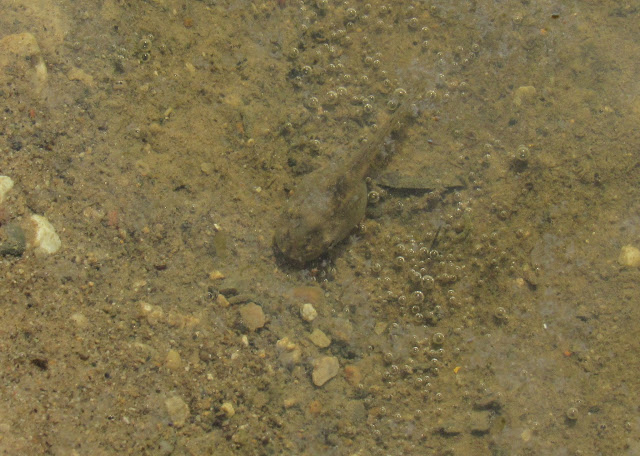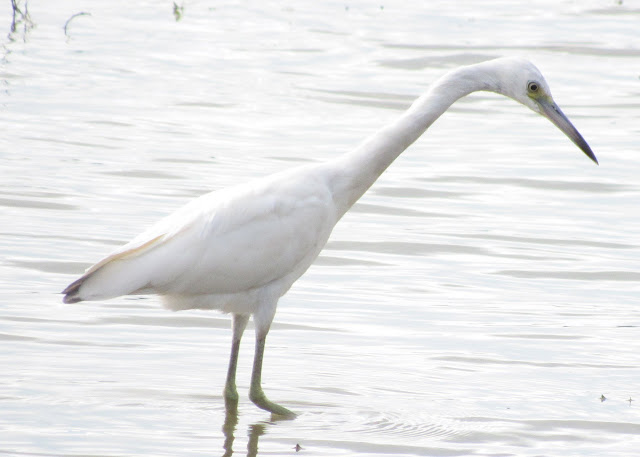I don't know how many of you have seen the news about it, but this is old hat to those who live in the area. We had a bit of a storm on August 12. By a bit of a storm, I mean that the area got five inches of rain in only a few hours, the majority falling in about an hour and a half. I drove through this storm on my way to a friend's house. All I could see was the taillights before me, about ten feet of the road, and a gray fog around me. It was easily the hardest drive I've ever done in my life. In the friend's neighborhood, I was driving up a road which had streams of water pouring down, pushing me back. Every sewer alongside the road was spewing back up. Finally, I made it to the house. However, the friend's front yard and drive were flooded and at least a foot deep:
I had another friend stranded at the Illinois State Fair that evening, where many vehicles and exhibits were ruined by up to five feet of water. For more on the State Fair flooding itself, see here.
I decided to go out on a drive the day after the flooding, a fine Saturday afternoon. I meandered over to Lick Creek Wildlife Area, where I found that a Raccoon had been there before me.
Another animal lay hidden in the grass. quite well camouflaged. Let's see if you can find it, above.
This Leopard Frog ( Lithobates spp.) hid in the grass nearby. Leopard Frogs are a confusing genus. This could be one of at least three species (Northern, Southern, or Plains) found in the area. My personal guess is Northern Leopard Frog, but I leave it to the experts.
Along the edge of the road, I found several small pools. Most were silt-covered, but the two closest to the end were clear and contained life, like this tadpole.
Several strange larvae, likely dragonfly larvae, swam about in the muck at the bottom of the shallow pool, food for a future heron, raccoon, or other predator that might wander past. A single tire could wipe out this pool in an instant. Frankly, considering the location, I'm surprised to find all this life.
The tadpoles blended in quite well against the dark tan soil underneath. After looking around for a bit, I wandered into the woods, surprised at the apparent lack of mosquitoes. After encountering a large spider in its web across the trail, I retreated and turned around. That was what the mosquitoes had been waiting for. I got eight bites in a minute and a half. The moral of this story is never turn your back on mosquitoes, or they will suck you dry.
Someone else was waiting on my car to suck me dry, but I spotted it first. This is some kind of Horsefly, with some of the weirdest eyes I've ever seen. It was sitting on top of my car, just waiting for me to come back. I got in my car after taking a few pictures and managed to avoid any more bites. After that, I drove off to the UIS campus. Since it had rained, the athletic fields were slightly flooded. If you don't know what that means, it means shorebirds.
Oh, and this fellow. One Northern Flicker (Colaptes auratus) randomly decided to perch here, at least a hundred feet from the nearest trees. This is a female, since there are no "moustache" lines.
Considering the flooding has driven ground-dwelling insects up from underground, and that the Northern Flicker is often on the ground digging for ground-dwelling insects, I'd imagine this bird has found a buffet, like the nearby sandpipers that I was hunting for.
This is a Least Sandpiper (Calidris minutilla), photographed through a fence. These tiny little birds are kind of (dare I say it?) just darn cute. For one thing, it's the size of a House Sparrow (for my non-birder friends, those brown birds you've all seen in your backyards). For another, they're fun to watch as they trot about, dipping their bill in the shallow grassy puddles and muddy spots.
The bird in the back of this photo has stumped several birders, but it's likely either a Semipalmated or a Least Sandpiper. Either way, both of these birds have a VERY long trip ahead of them. Least Sandpipers fly from the Arctic Circle to as far away as Brazil or Chile... and back.. every year. On the way, they stop through Illinois, generally in May and August.
By contrast, the most common sandpiper species in Illinois, the Killdeer (Charadrius vociferus), stays here or goes just a bit south. About sixty of these birds were resting on a gravel strip nearby.
The best birds, however, were a pair of Lesser Yellowlegs (Tringa flavipes), foraging in a nearby temporary pool which this year has not been temporary. There are at least sixty Canada Geese in the vicinity, so I recommend birdwatching from the car at this locality. Also, since school begins soon, I don't recommend birdwatching here at all from now on.
Like the Least Sandpipers, the Lesser Yellowlegs migrates a LONG way away, but in this case, these birds go as far south as the Straits of Magellan, north to the Yukon. That's a lot of miles. I want to drive it all someday. Just so you know, it is a life goal of mine to drive from Alaska to Argentina. Currently, I can't, thanks to about sixty miles of road missing from southern Panama. Lesser Yellowlegs, of course, can just fly right on by.
While we're on the topic of migration, I'd like to mention an unusual type of migration. That would be the instance of a southern bird migrating north. While a couple of oceanic birds do migrate from South America north, the few other examples are birds that fly north from the South in late summer. This happens often enough that we can't just call these birds lost, per say. One of these is the Little Blue Heron. Immature Little Blue Herons, which are white in color, fly north in late summer, in what scientists have termed post-breeding dispersal. In other words, the kids are moving out, and they don't know where to go. Sometimes they go to Illinois, until they realize where they are and leave.
Now, I've been dying to see a Little Blue Heron (Egretta caerulea), and I was thinking about this rather suddenly as I crossed the Lindsay Bridge to get to Lake Springfield Beach. I literally thought, "Wouldn't it be funny if I saw a little blue on the beach?" Well, lo and behold:
Yup. It is. In one of the more interesting incidents of my birding career of the last eight months (and that's saying quite a bit, considering all that's happened), I thought of a bird that has no rights to be here in Central Illinois, and it was. Coincidence? I think so.
Now, some of you may be wondering how I can tell this apart from an egret or some other white heron-like bird. First off, it's tiny compared to a Great Blue Heron. Second, it has a metallic blue upper bill, quite distinctive in the photo above. Third, I had an egret to compare it with:
While Great Egrets (Ardea alba) are not uncommon in Central Illinois, they are very uncommon at Lake Springfield Beach. And yet here one was, foraging on the outer swimming divider, which is usually not underwater as it is above. Nor was this the last rare bird to be seen here:
Among the sixty or so Ring-billed Gulls, about forty Caspian Terns (Hydroprogne caspia) could be seen resting on the beach. This has since swelled to about a hundred Caspian Terns in the week following. Caspian Terns have been present off and on here all year, but ordinarily would be found further north. I think it is solely the refuge of the fenced-off beach that has kept them here.
So, in this one spot, we had two traditionally southeastern herons and a traditionally northern tern species. Furthermore, that wasn't all. A lone Spotted Sandpiper (Actitis macularius), the first I've seen in winter plumage, foraged in the shallows between the Little Blue Heron and the tern colony. It was a remarkably busy place, and whilst I'm photographing all of this, there was a wedding in the Beach House. Occasionally, the guests would stare at me from the veranda. I'm used to getting a few weird looks and questions as I run about photographing birds, so this was fine.
I then left the wedding (and the birds) alone. During the night, the Little Blue Heron and the Spotted Sandpiper flew off. I wonder if they'll ever come back. Recently, I learned that the beach is scheduled to reopen to visitors as soon as next year. This spot is the #2 birding spot in Sangamon County, and I'm thankful that I found these birds whilst it is still intact. The following morning, I took a trip with a friend...
TO BE CONTINUED






















No comments:
Post a Comment